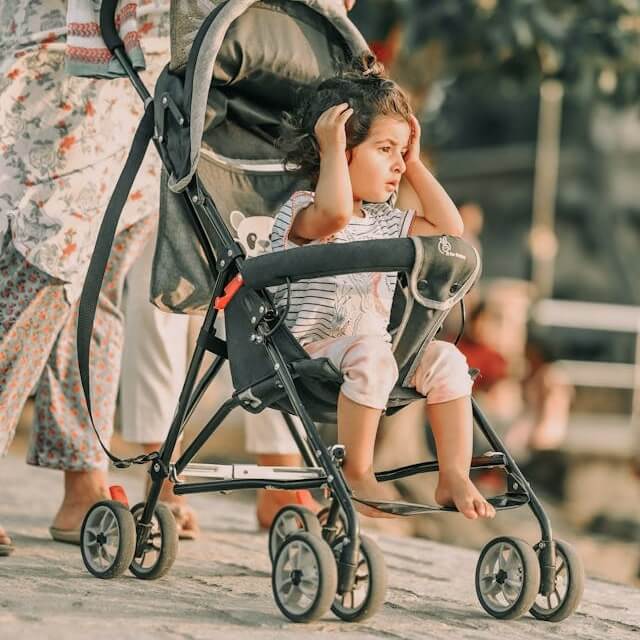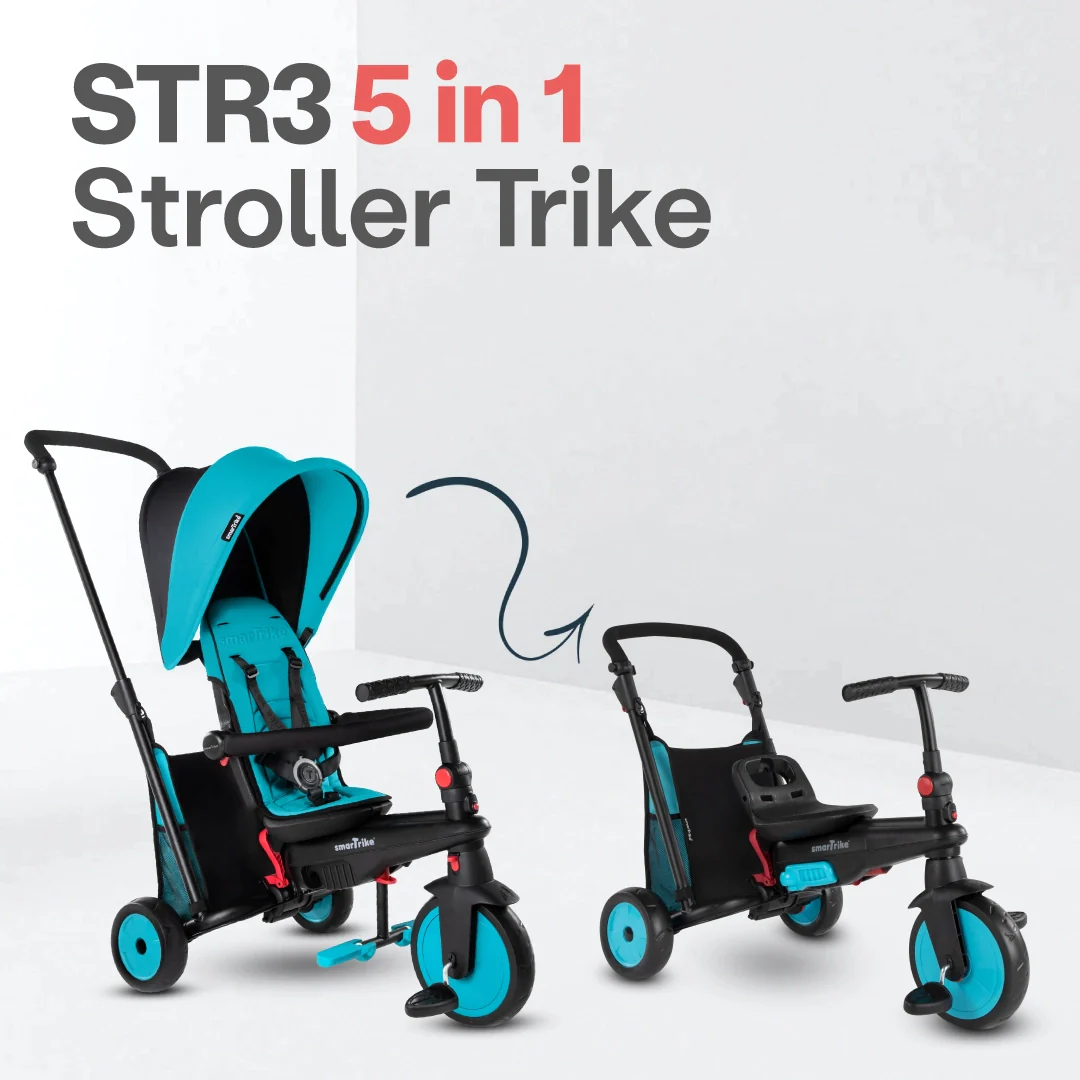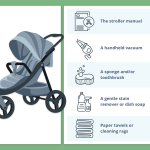Have you ever wondered when it’s the right time to pack away your child’s stroller? This question lingers in the minds of many parents as their little ones grow.
It’s not just about age; it’s about readiness, independence, and convenience. When your child is comfortable enough to walk long distances or prefers exploring the world on their own two feet, it might be time to say goodbye to the stroller.
But how do you know for sure? Understanding when to stop using a stroller can save you time, energy, and even a bit of sanity. Let’s delve into the factors that will help you decide the perfect moment to make this transition. You might be surprised at what you discover!
Developmental Milestones
Understanding developmental milestones helps parents decide when to stop using strollers. These milestones indicate a child’s physical and mental growth. Children develop at their own pace. Yet, certain stages are common across most children. Knowing these stages can guide your decision on stroller usage. It’s essential to recognize when your child is ready for more independence. Let’s explore some key developmental milestones.
Physical Growth And Walking Skills
Walking is a major milestone for toddlers. Most children start walking between 9 and 15 months. By age 3, many walk steadily and run short distances. This newfound mobility decreases the need for a stroller. Encourage walking to build strength and coordination. Walking also promotes exploration and independence.
Social And Emotional Development
As children grow, their social skills improve. They enjoy interacting with peers and exploring their environment. By age 3, most toddlers can follow simple directions. They understand basic rules and routines. This development supports longer periods without a stroller. Walking becomes a social activity, enhancing emotional connections.
Cognitive Skills And Curiosity
Curiosity peaks as cognitive skills develop. Children become eager to explore and learn about their surroundings. By age 2, they start solving simple problems. They ask questions and express their interests. Walking without a stroller allows them to satisfy their curiosity. It offers more opportunities for learning and discovery.
Building Independence And Confidence
Walking independently boosts confidence in young children. It fosters a sense of achievement and autonomy. Children learn to navigate their world and make decisions. This independence encourages them to rely less on strollers. It also strengthens their self-esteem and social skills.

Credit: www.parentingtogo.ca
Physical Readiness Indicators
Children often stop using strollers between ages three and five. This depends on their physical readiness. Factors include their ability to walk longer distances and maintain balance. Parents should observe their child’s comfort and confidence when deciding.
Understanding when your child is ready to stop using a stroller can be challenging. It involves recognizing physical readiness indicators that signal your child is prepared to walk more independently. Observing these signs can help you make an informed decision, ensuring a smooth transition from stroller to foot.1. Increased Stamina
One of the first signs your child might be ready to ditch the stroller is increased stamina. Notice if they can walk longer distances without needing a break. If your toddler insists on walking during outings and seems full of energy, it may be time to consider leaving the stroller behind.2. Improved Balance And Coordination
Pay attention to your child’s balance and coordination. If they can navigate uneven surfaces like grass or gravel without stumbling, they are likely developing the necessary physical skills. This improved coordination is a strong indicator of readiness to walk unaided during daily activities.3. Height And Weight Considerations
Check if your child is starting to outgrow the stroller physically. Most strollers have weight limits, typically around 50 pounds. If your child is nearing or has surpassed this limit, it might be a sign that they are ready to transition away from the stroller.4. Expressing Independence
Children often express a desire for independence as they grow. If your child frequently resists being placed in the stroller and prefers to walk beside you, it is a clear signal. Encouraging this independence can boost their confidence and walking skills.5. Ability To Follow Instructions
Consider whether your child can follow simple instructions. Can they stop at the corner or hold your hand when crossing the street? If yes, they are likely ready to walk safely in more public settings without the need for a stroller. Recognizing these physical readiness indicators can help guide your decision on when to stop using a stroller. Have you noticed any of these signs in your child? Trust your instincts and their capabilities to find the right time for this transition.Health And Safety Considerations
Choosing the right time to stop using a stroller involves safety and health considerations. Most experts recommend transitioning between ages three to five. This change supports a child’s physical development and encourages independent walking.
Understanding when to stop using a stroller involves many factors. Health and safety are key. Parents want their children safe and comfortable. They also want to ensure healthy development.Physical Development
Children grow quickly. Their muscles and bones change rapidly. A stroller might restrict this natural growth. Walking helps strengthen their muscles. It also improves coordination.Promoting Independence
Walking without a stroller fosters independence. It encourages exploration and curiosity. Children learn to navigate their surroundings. This builds confidence and decision-making skills.Safety In Crowded Areas
Busy places can be dangerous for young walkers. A stroller provides a safe space. It helps avoid accidents in crowded settings. Parents can keep their children close and secure.Environmental Awareness
Walking exposes children to their environment. They observe and learn about the world. A stroller limits these experiences. Walking increases awareness of surroundings and social interactions.Assessing Individual Needs
Every child is unique. Some may need a stroller longer. Consider their physical abilities and comfort. Evaluate their readiness to walk more independently. `Age-based Recommendations
Deciding when to stop using a stroller can be a tricky question for many parents. While there isn’t a one-size-fits-all answer, age-based recommendations can offer a valuable guide. Consider these insights to make an informed decision that best suits your child’s needs and your family’s lifestyle.
Infants And Toddlers
For infants and toddlers, strollers are a lifesaver. They provide comfort and security while you navigate daily errands or enjoy leisurely walks. It’s common for children up to age three to use strollers regularly.
Think about your child’s energy levels. If your toddler still tires easily, a stroller may be necessary for longer outings. Balance their need for exploration with practical concerns like safety and convenience.
Preschoolers
By preschool age, most children are ready to ditch the stroller. They are more active and curious, eager to walk alongside you. This is the age to encourage independence and physical activity.
Ask yourself: does your child show interest in walking more? If yes, start transitioning away from the stroller. Gradually introduce them to walking short distances without it. It’s a great way to boost their confidence and stamina.
Older Children
Once children reach five or older, strollers should be a thing of the past. Most kids at this age are capable of walking longer distances. Encourage them to explore their surroundings and engage more actively in outdoor activities.
Consider your child’s development. Are they physically capable and interested in walking? If they are, it’s time to say goodbye to the stroller. Use this opportunity to foster their growth and autonomy.
Personal Experience
I recall my son’s excitement when he walked to the park without his stroller for the first time. His pride was evident, and it marked a milestone in his growth. Moments like these show the importance of transitioning at the right age.
Reflect on your own experiences. Have you noticed changes in your child’s readiness to walk independently? Trust your instincts, and let those insights guide your decision on when to stop using a stroller.
Final Thoughts
Consider your child’s physical and emotional readiness when making this decision. Age-based recommendations are helpful, but ultimately, your child’s unique needs should guide you.
What do you think is the best age to let go of the stroller? Share your thoughts and experiences, as they can be invaluable to other parents facing the same dilemma.
Environmental Factors Impact
Deciding the right age to stop using a stroller involves many factors. Among them, environmental conditions play a significant role. Different climates and terrains can influence how long a stroller is necessary. Parents must consider these conditions for their child’s safety and comfort.
Climatic Conditions
Weather affects how often a stroller is used. In hot climates, strollers provide shade and comfort. They offer a place to cool down during a walk. In contrast, cold environments may require strollers with covers. These covers protect children from wind and snow. Seasonal changes also impact stroller usage.
Terrain Challenges
Uneven or rough terrains make strollers essential. They ensure a smooth ride on bumpy paths. City sidewalks or rural trails each have unique challenges. A sturdy stroller is crucial for navigating these areas safely. Parents may rely on strollers longer in such places.
Public Transportation
Stroller use depends on local transport options. In cities with crowded public transport, strollers offer convenience. They help parents manage their child’s safety in busy areas. In places with limited transport, strollers are necessary for longer durations. They make travel easier for both parents and children.
Urban Vs. Rural Living
Urban and rural settings influence stroller needs. City life might require more frequent stroller use. Streets are busier and distances longer. In rural areas, open spaces might reduce the need for strollers. Children can walk safely and freely. Stroller usage varies significantly between these environments.

Credit: www.craft-child.com
Parental Preferences And Lifestyle
Choosing when to stop using a stroller is a personal decision. Parental preferences and lifestyle play a significant role. Some parents prefer to keep strollers for convenience. Others might transition earlier due to their active lifestyles.
Parental Preferences
Every family is different. Some parents value the ease of a stroller. They enjoy the simplicity of transporting a child during outings. It offers a comfortable space for a child to rest. This choice often aligns with a parent’s daily routine. A stroller can be a lifesaver during long shopping trips or walks.
Other parents might focus on independence. They encourage their child to walk at an early age. This decision might stem from a desire to promote physical activity. Parents who choose this route might see benefits in their child’s development. Walking can enhance coordination and physical strength.
Lifestyle Influence
Active lifestyles often influence stroller use. Families that frequently travel might rely on strollers longer. They offer ease during airport transits and public transportation. For families with multiple children, a stroller can be essential. It helps manage the chaos of moving around with young kids.
Conversely, families with busy schedules might opt for walking. They might find strollers cumbersome during quick errands. For parents involved in sports or outdoor activities, walking might be preferred. This approach aligns with their active lifestyle choices.
Alternatives To Strollers
As children grow, the stroller becomes less practical. Parents often seek alternatives to strollers that fit their child’s developmental stage. Some options provide comfort and security for both parent and child. These alternatives encourage freedom and independence for the child while maintaining safety.
Baby Carriers
Baby carriers offer a close and secure option for parents. They allow parents to keep their hands free while keeping their child close. Different styles suit various needs, like front or back carriers. They are perfect for crowded places or nature walks. Soft and adjustable, they provide comfort for both parent and baby.
Walking Assistance Tools
Walking assistance tools help toddlers learn balance and coordination. These tools encourage independence while providing support. Push toys and walkers are popular choices. They motivate children to take steps confidently. They are safe for indoor and outdoor use. Parents can choose from various designs to match their child’s interest.
Transition Strategies
Transitioning from a stroller to walking independently is a big step. For many parents, this phase can be both exciting and challenging. Knowing the right strategies can make this transition smoother for both parents and children.
Understanding Your Child’s Readiness
Look for signs that your child is ready to stop using a stroller. These signs may include increased curiosity, wanting to walk more, and improved balance. Pay attention to your child’s energy levels and enthusiasm for walking.
Encourage Short Walks
Start with short walks around your neighborhood. This helps your child get used to walking longer distances. Keep the walks fun and interactive. Point out interesting things along the way. Encourage them to explore their surroundings.
Build Confidence Gradually
Help your child build confidence by letting them walk in safe spaces. Parks and playgrounds are great places to practice. Make sure they know it’s okay to take breaks. Praise their efforts and celebrate small achievements.
Use A Balance Bike Or Scooter
Consider introducing a balance bike or scooter. These can be fun alternatives to strollers. They help improve balance and coordination. Choose a model that suits your child’s age and skill level. Ensure they wear protective gear for safety.
Plan For Rest Breaks
During longer outings, plan for rest breaks. Allow your child to sit and relax. Bring a portable chair or blanket if needed. This prevents fatigue and keeps the experience enjoyable.
Stay Positive And Patient
Remember, patience is key during this transition. Stay positive and supportive. Encourage your child at their own pace. Every child is different. What works for one may not work for another.
Expert Opinions
Parents often wonder about the right age to stop using a stroller. Experts suggest that most children are ready by age 3. Each child develops differently, so consider their physical growth and independence before making the decision.
Choosing the right time for your child to stop using a stroller can feel like a challenging decision. Expert opinions vary, offering diverse perspectives on this milestone. Understanding these insights can help you make a choice that best suits your child’s development and your family’s lifestyle.Understanding Developmental Milestones
Experts often highlight the importance of considering your child’s developmental milestones. Around age three, many children begin to exhibit stronger walking abilities and increased endurance. This is a key indicator that they might be ready to ditch the stroller. You might notice your child is eager to walk longer distances without showing signs of fatigue. If this sounds familiar, they might be ready to move on from the stroller.Health Professionals’ Advice
Pediatricians often suggest balancing stroller use with opportunities for physical activity. While strollers are convenient, kids need to move and explore to support healthy growth. Encourage your child to walk short distances during outings. This can boost their confidence and physical development. Consult your pediatrician for personalized advice if you’re unsure about your child’s readiness. They can offer guidance tailored to your child’s specific needs.Practical Considerations
Lifestyle factors play a crucial role in making this decision. If you live in a bustling city, a stroller might offer safety and convenience for longer. However, if your environment is more relaxed, you might feel comfortable letting your child walk more independently. Consider your daily routine. If walking long distances is common, a stroller might be necessary longer. But if most trips are short, transitioning away from the stroller might be easier.Personal Experiences
Reflecting on personal experiences can offer valuable insights. I remember the day my toddler insisted on walking home from the park. It was a moment of pride and realization that he was ready for more independence. Have you experienced similar moments where your child expressed a desire to walk instead of ride? These instances can be telling signs that they are ready to move on from the stroller. What is your child’s attitude towards walking? Are they eager to explore, or do they prefer the comfort of the stroller? Observing these behaviors can offer clues about their readiness. Ultimately, the decision is personal and should align with your child’s developmental stage and your family’s lifestyle. Consider expert opinions, but trust your instincts as a parent.
Credit: smartrike.co.uk
Common Myths And Misconceptions
Many believe children should stop using strollers by age three. Individual needs and development vary greatly. Parents often decide based on mobility and comfort.
When it comes to deciding the right age for children to stop using strollers, many parents find themselves tangled in a web of myths and misconceptions. These myths can sometimes lead to confusion and unnecessary worry. Let’s unravel some of these common myths and offer you clarity on this topic.Myth 1: Children Should Stop Using Strollers By Age 3
Many parents believe that by age three, children should no longer need strollers. This myth can create unnecessary pressure. While some kids may be ready to walk longer distances by this age, others may still need a stroller for comfort and safety.Myth 2: Using Strollers For Older Kids Is Lazy Parenting
Some people think that using a stroller for an older child is a sign of lazy parenting. This misconception overlooks the practical reasons parents might choose to use strollers. Long family outings or crowded events can be overwhelming for young children, and strollers provide a safe space for them to rest.Myth 3: Strollers Hinder A Child’s Physical Development
There is a belief that frequent stroller use may impede physical development. However, this isn’t necessarily true. Occasional stroller rides, especially during long trips, don’t replace active playtime or physical activity. Balance is key.Myth 4: All Strollers Are Created Equal
Thinking that all strollers serve the same purpose is another common misconception. Lightweight strollers differ from full-sized ones in functionality and comfort. Assess your child’s needs and your lifestyle before making a choice.Myth 5: You Should Follow What Other Parents Are Doing
It’s easy to feel pressured by what other parents are doing. Remember, every child is unique. What works for one family might not work for yours. Trust your instincts and your child’s cues. Reflect on your own experiences. Have you ever felt judged for using a stroller with an older child? Let go of these myths and focus on what works best for your family. Your understanding of your child’s needs is your best guide.Frequently Asked Questions
Do I Still Need A Stroller For A 3 Year Old?
A stroller can still be useful for a 3-year-old. It provides convenience for long outings, naps, and tired legs. Consider your child’s activity level and your lifestyle needs. A lightweight or compact stroller might be beneficial for ease of use and transportation.
Does A 4 Year Old Need A Stroller At Disney?
Yes, bringing a stroller for a 4-year-old at Disney is advisable. They might get tired walking all day. Strollers provide comfort, rest, and storage for essentials. Many parents find them helpful for navigating large crowds. Consider renting a stroller at the park for convenience.
Can A 7 Year Old Be In A Stroller?
Yes, a 7-year-old can use a stroller if they need assistance. Consider the child’s comfort and stroller’s weight limit. It’s a personal choice based on the child’s needs and parent’s convenience. Choose a sturdy stroller designed for older children for optimal support and safety.
Is There An Age Limit For Strollers?
Most strollers are suitable for children from birth up to around 3-4 years old. Always check the manufacturer’s age and weight recommendations for specific guidelines. Stroller features may vary, impacting suitability for different ages. Regularly assess if your child still fits comfortably and safely within the stroller’s specifications.
Conclusion
Deciding when to stop using a stroller depends on your child’s needs. Most kids outgrow strollers around age three. They become more active and enjoy walking. It’s important to consider their safety and comfort. Listen to their cues. Are they ready to walk more?
Observe their energy levels. Walking helps build strength and independence. Every child is unique, so adapt to their pace. Trust your instincts and your child’s development. By understanding these factors, you can make a confident decision. Enjoy your outings together without a stroller!


